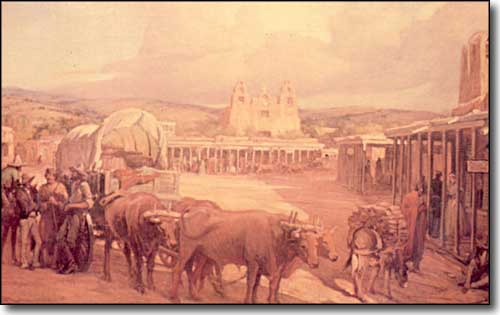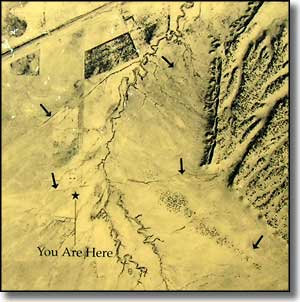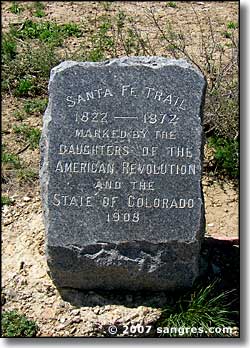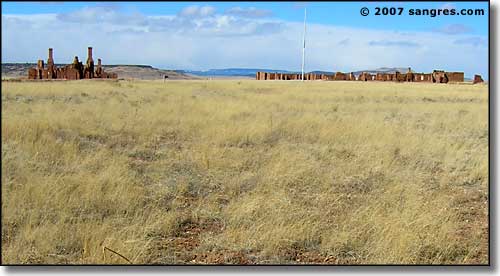 |
Santa Fe National Historic Trail
|
 The Santa Fe Plaza in early Trail days |
 An aerial photo from the 1930's showing wagon wheel ruts from different versions of the Trail around Iron Spring Santa Fe Trail Timeline:
Pre 1540 - American Indians establish trade and travel routes that later become part of the Santa Fe Trail. 1540-1541 - Francisco Vazquez de Coronado explores from Mexico to Kansas. 1601 - Juan de Oñate spends 5 months traveling with wagons and artillery through the Plains. 1739 - Paul and Peter Mallet make the first French trading venture to Santa Fe from Illinois country. 1792 - Frenchman Pedro Vial travels from Santa Fe to St. Louis for the Spanish government. 1819 - Financial panic creates a need for hard currency in the Missouri Territory. Adams-Onis Treaty between U.S. and Spain makes the Arkansas River the international boundary. 1821 - Mexico declares and wins independence from Spain. William Becknell's party from Missouri is welcomed in Santa Fe (Becknell is credited with opening the Santa Fe Trail). 1825 - Senator Thomas Hart Benton of Missouri arranges for U.S. Government to survey the Trail. 1833-1834 - William and Charles Bent and Ceran St. Vrain build Bent's Old Fort on the Arkansas River in Colorado. 1836 - Texas wins independence from Mexico. 1844 - Trader Josiah Gregg chronicles his trips over the Trail in Commerce of the Prairies. 1846 - Steven Watts Kearny leads the Army of the West over the Mountain Branch of the Trail at the beginning of the Mexican-American War. He sent a letter ahead of him informing the Mexican Governor in Santa Fe that he was coming. When he arrived at Santa Fe, the Mexican authorities had evacuated themselves and headed south to what is now Mexico. The Americans essentially took Nuevo Mexico without firing a shot. 1848 - Mexican-American War ends. United States acquires almost half of Mexico's lands in Treaty of Guadalupe Hidalgo. |

1849-1852 - California Gold Rush increases Trail traffic. 1851 - Fort Union is established to help protect Trail commerce. 1861-1865 - U.S. Civil War. 1862 battle at Glorieta Pass holds the Southwest for the Union. 1869 - Trail grows shorter as railroads push westward across Kansas. "Uncle Dick" Wootton improves the Trail over Raton Pass and then opens it as a toll road. His improvements cut the time needed to cross the Pass in half. 1878 - Atchison, Topeka & Santa Fe Railroad reaches Raton Pass on the Mountain Route and buys Uncle Dick's toll road to use for the train. 1880 - AT & SF Railroad reaches Santa Fe. Santa Fe Trail slips into history. 1906 - The Daughters of the American Revolution begin erecting Trail markers. 1986 - Santa Fe Trail Association forms to help preserve and promote awareness and appreciation of the Trail. 1987 - Congress designates Santa Fe National Historic Trail under the National Trails System Act. |

The San Luis Valley Branch of the Mountain Branch of the Santa Fe Trail descends to the ever-full watering holes in the bottom of Tinaja Canyon in eastern Huerfano County between these upturned rocks. |
 Wagon ruts on the Trail, near Fort Union  Santa Fe Plaza today (the monument marks the end of the trail) |

|
| Index - Arizona - Colorado - Idaho - Montana - Nevada - New Mexico - Utah - Wyoming National Forests - National Parks - Scenic Byways - Ski & Snowboard Areas - BLM Sites Wilderness Areas - National Wildlife Refuges - National Trails - Rural Life Advertise With Us - About This Site - Privacy Policy |
|
I think the painting at the top of this page is from the Museum of New Mexico. Photos courtesy of Sangres.com, CCA ShareAlike 3.0 License. Text Copyright © by Sangres.com. All rights reserved. |